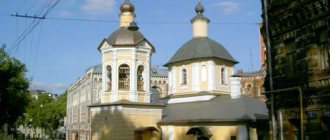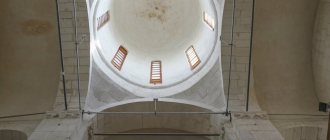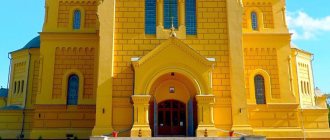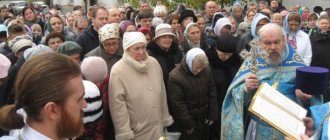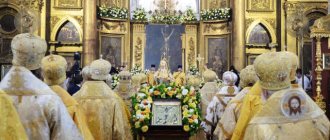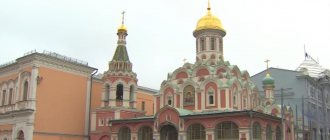Temple on the Hill
Yuri Ivanov, ktitor* of the Prince Vladimir Cathedral and general director of the group (pictured left), and Metropolitan Kirill of Stavropol and Nevinnomyssk (center) discuss the design of the cathedral iconostasis.
Photo by the press service of the Stavropol Metropolis The cathedral in honor of the Holy Equal-to-the-Apostles Prince Vladimir grew up in a new microdistrict in the southwest of Stavropol in less than two years. Back in 2021, Metropolitan Kirill of Stavropol and Nevinnomyssk consecrated the construction site, and in July 2021, on the day of the celebration of the 1030th anniversary of the Baptism of Rus', the first Divine Liturgy was already served in the cathedral. This is one of the highest points of Stavropol - from the square in front of the cathedral in clear weather you can see the Caucasus ridge and the snow caps of the double-headed Elbrus. And nearby - just cross the road - there are apartment buildings, a school, kindergartens. This is the new Perspektivny microdistrict, built, like the temple, by Yuri Ivanov’s group.
The Cathedral of St. Prince Vladimir was built for the residents of this microdistrict.
The building is completely new, but when you look at it, temples with centuries of history come to mind, like the ancient Cathedral of John the Baptist in Kerch. “We didn’t want to invent something new, we wanted to repeat what was created many centuries before us,” explains Archpriest Alexander Gomzyak, head of the construction department of the Stavropol and Nevinnomyssk diocese.
Construction of the Prince Vladimir Cathedral, April 2021. Photo from the YugStroyInvest archive
Some things are still being completed on the territory of the temple, but there is already a children's playground and a fountain decorated with the figure of an angel. A belfry with 12 bells is attached to the front facade of the cathedral. They say they can be controlled from a mobile phone through a special application - several dozen melodies to choose from!
A spiritual and educational center is already being built next to the temple - with a Sunday school, a social support service, a warehouse for humanitarian aid and a parish library. And over time, an Orthodox secondary school should open nearby.
“We go here for a walk,” says one of the mothers we met on the playground near the temple. “There’s a lot of space here, a good children’s playground, and children have somewhere to climb.” “We come here often,” says the grandfather of a boy of about eight. - And we look into the temple. And in the fall we’ll go to Sunday school.”
Great consecration of the Prince Vladimir Cathedral. Liturgy in the newly consecrated church. Photo by the press service of the Stavropol Metropolitanate
We leave the cathedral fence and find ourselves at yet another construction site, the same size as the temple grounds. There will be a second park here - a corner for family recreation. With sports fields, a family cafe, a stage with an amphitheater, sculptural compositions on the themes of Christian holidays and landscape design elements like a “dry stream” made of stones. Most of the park will be occupied by trees and ornamental shrubs, lawns and flower beds. “Our goal is to make people want to come here with their children and relax. And of course, go to the temple,” explains Alexey Ivanov, deputy general director of the group.
The population of Stavropol is a little over 437 thousand. And although the city does not seem small, you can easily travel around it from end to end on a bicycle. Svetlana Dubinina, a parishioner and head of the social service of the Vladimir Cathedral, talks about this.
Parishioners of the Prince Vladimir Cathedral collect gifts for patients in the pediatric oncology and hematology department of the Stavropol Regional Hospital. Photo from the cathedral archive
There are 42 Orthodox parishes in the city, 16 of them appeared quite recently - according to the “20x20” program, launched by the Stavropol and Nevinnomyssk diocese on behalf of Patriarch Kirill. Four more plots of land are ready for development, so that a church in every district of Stavropol will be within walking distance - like a school, a pharmacy, a clinic. Only then will people’s lives change, Father Alexander Gomzyak is sure. And the Vladimir Cathedral was built precisely for this purpose - so that life around would change.
New settlers in search of truth
There are about seventy thousand residents in the Perspektivny microdistrict, which is very decent by Stavropol standards. Slightly less than half of them are young families who bought an apartment with a mortgage. “We notified apartment buyers through social networks that there would be a temple here, and people reacted very positively,” recalls Alexey Ivanov.
“I bought an apartment here when I found out that a temple was being built next to the house,” says Svetlana Dubinina. Some of her friends did the same. Now they work as volunteers at the temple.
Metropolitan Kirill of Stavropol and Nevinnomyssk consecrated the construction site of the Spiritual and Educational Center of the Cathedral of St. Equal-to-the-Apostles Prince Vladimir. Annunciation of the Blessed Virgin Mary, April 7, 2021. Photo by the press service of the Stavropol Metropolitanate
The first service in the cathedral took place on the patronal feast day, the day of remembrance of the Holy Equal-to-the-Apostles Prince Vladimir - July 28, 2018. And in the fall, services were held here every day. At the same time, Sunday school classes and social work began. Today, under the care of the Prince Vladimir parish there are several large and low-income families and parents with disabled children. “We collect things for them, make gifts for the holidays, and invite them to our events,” says Svetlana.
And priests and volunteers regularly visit young patients in the department of pediatric oncology and hematology of the regional children's clinical hospital of Stavropol. “In this place, children with a terrible diagnosis lie and are treated for many months, or even several years, and their consciousness is turned upside down,” shares the cathedral cleric, Priest Andrei Chursinov. “I would like to say something to these children, to help somehow.” But sometimes you don’t even need words: you come in, bless them, take them by the hand, sit next to them, give them a toy. Some children have only a few days to live, but they still enjoy their toys.”
Children's playground near the Prince Vladimir Cathedral. Photo by Yulia Makoveychuk
Having secured permission from parents and teachers, the priests began attending the local school. As a result, 90% of parents enrolled their children in “Fundamentals of Orthodox Culture.” “The main thing we can and must do is to “ignite” the children so that they become involved in a spiritual search,” says Father Andrei. “And whoever seeks the truth will certainly find it.”
And for adults, the priests of the Vladimir Cathedral conduct live broadcasts on Instagram on Fridays: “Baptism”, “Christianity and Paganism” and many other topics. Their regular audience is about a hundred people. “Unfortunately, people are very superstitious. Although here, among the Cossack population, there are fewer superstitions than in Central Russia. But you still need to fight them,” explains the priest.
In the summer, on Sundays in the Vladimir Cathedral, 150-200 people receive communion, and on major holidays - 400-500. “They also come from other regions,” says Father Andrei. “And every day we have three or four baptisms in the cathedral.” And if a person cannot pay, then we baptize and marry for free. Moreover, Metropolitan Kirill sends people who are unable to make a donation for baptism to us.”
Sermon before communion on the day of the Feast of the Annunciation, 2021. Photo by the press service of the Stavropol Metropolis
Less than a year had passed since the temple began to operate, and life around it was already in full swing. “There are already a hundred children in Sunday school, we invite former school teachers to teach - the priests are overloaded, although there are four of them, not counting the deacon,” explains Svetlana Dubinina. “If this continues, we will build another church - at the other end of the microdistrict,” adds Archpriest Alexander Gomzyak.
Family Affair
Yuri Ivanov, General Director of USI, has been working towards the construction of the cathedral for many years. He had helped the Stavropol diocese before: he reconstructed the old church in the village of Ptichye, where he spent his childhood; with his funds, a temple was built in the village of Novomikhailovsky, where he was born; he donates funds to the St. John-Mary and St. George convents, the Stavropol churches of St. Sergius of Radonezh and Alexander Nevsky; The company he founded in 2003 participated in the restoration of the cathedral in honor of the Kazan Icon of the Mother of God.
But this was the first time Yuri Ivanovich had taken on such a large-scale project as the construction of a cathedral, so he even brought this idea to the family council. After all, the temple is not a residential complex or a shopping center; it is a non-profit project, not designed for a return on investment. Those close to him not only approved the idea, but also became his reliable support and help.
Today Yuri Ivanov is an honorary ktitor of the cathedral. The temple complex is actively developing primarily on his initiative. Even at the stage of construction of the microdistrict, Yuri Ivanovich became seriously concerned about what infrastructure facilities its residents might need in the future. His son Alexey recalls: “There are minimum requirements for housing developers, and we met them all: we built a school, five kindergartens, and sports grounds. And then we thought - what else is needed? And they decided - a temple! Then there will be wholeness, completeness.”
St. Andrew's Cathedral (Stavropol)[edit]
St. Andrew's Cathedral, one of the main churches of the entire Stavropol Territory, has been operating for more than a hundred years and is one of the most important churches of the entire Stavropol Territory. This is a large four-pillar, single-domed temple, made in the Russian-Byzantine style, very beautiful inside and out. Located in the central part of the city. The Bishop's Forest is located nearby. The Stavropol and Vladikavkaz diocese of the Russian Orthodox Church was established in 1843 with its center in the city of Stavropol. Initially, the diocese was called Caucasian and Black Sea, later Caucasian and Ekaterinodar, Stavropol and Ekaterinodar, Stavropol and Baku, and since 1998 - Stavropol and Vladikavkaz.
Address
: Russia, Stavropol region, Stavropol, st. Dzerzhinsky 157
“The temple is also a social object”
Do city planners, when planning new areas, often think about the fact that their future residents may sooner or later need a temple? Do they often choose a good place for it in advance? You involuntarily think about this after wandering around the territory of the new Stavropol microdistrict and talking with the initiators of the construction of the Vladimir Cathedral.
There is no doubt that the local residents really needed this cathedral. There is no doubt that the decision to build this temple on a new, undeveloped territory adjacent to the city turned out to be very successful. The builders did not have to invade the already established urban terrain, and there was no risk of causing discontent among the neighbors: it turned out to be quite simple to secure the consent of future residents of the area and the support of the local administration. There were no questions with either one. And a rare, I think, opportunity for our country presented itself to take care of the residents of the microdistrict under construction from all sides at once.
Archpriest Alexander Gomzyak hopes that the history of the Vladimir Cathedral will lay the foundation for many other churches near new buildings, and, perhaps, not only in Stavropol. “In general, it seems to me that the construction of any residential area should begin with the foundation of a temple,” he says. “After all, a temple is also a social object, and perhaps one of the most necessary.”
Kazan Cathedral (Stavropol)[edit]
On June 22, 1843, between Gostiny Ryad and the commissariat buildings on the eastern end of Fortress Mountain, a place was allocated for the foundation of a new temple; On July 8, 1843, with a large crowd of people, a solemn ceremony of laying the foundation of the temple took place, which was consecrated by Bishop of the Caucasus and Black Sea Jeremiah (Soloviev).
In 1847, the construction of the temple was completed, by decree of the Holy Synod it was given cathedral status, and on October 22 its consecration took place.
In 1858-1873, according to an individual design by the Stavropol architect Pavel Voskresensky, a four-tier bell tower 98 meters high was built to the west of the cathedral.
In the basement of the Kazan Cathedral, respected people of the city found rest.
Address:
Suvorova, 1a, Stavropol 355035, Russia
